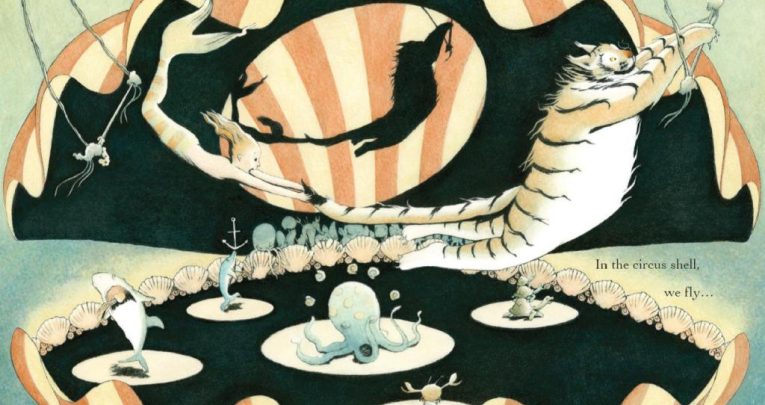10 Topics To Teach Using Children’s Books With Hidden Depths

Friendship, loss, memory, war and hope – children’s books get to the heart of what it is to be human, so why not explore their many layers of meaning with your class, suggests Carey Fluker Hunt…

1. The Sea Tiger by Victoria Turnbull (Templar)
What’s the story?
Oscar is a mer-boy. The Sea Tiger is his best (and only) friend, and they spend their days playing in an underwater paradise. But things can’t stay the same forever. Oscar needs to grow up and move on – and to be a true friend, the Sea Tiger must help him.
Delicately drawn and with a muted colour palette, Victoria Turnbull’s illustrations possess a quiet exuberance that’s complemented by her poetic text.
Deep thinking
Themes include friendship, caring, understanding someone else’s needs, loss, growth and change.
Try this…
- Talk about the changes your children have experienced, and how these experiences made them feel (e.g. starting school, moving house, losing a pet…). How can we help each other through difficult times, as well as enjoying the good things together?
- Pretend to be the Sea Tiger and find ways for him to move and speak and roar. Use chalky pastels and watereddown inks to create your own underwater pictures. If the children could have an imaginary animal friend, what would they choose and what adventures would they have?
- How should we treat our human friends to show them we care?
2. Little Answer by Tim Hopgood (Random House)
What’s the story?
When the answer’s always sausages, finding the right question is very important. Readers will enjoy Little Answer’s predicament as he searches for his One True Question. Will it be what clouds are made of, or what is the secret to happiness? Or maybe it’ll just be what’s for tea tonight?
This is a book that will be read and re-read for the sheer enjoyment of it, but it’s the underlying messages about the importance of asking questions and never giving up that take Little Answer to another level.
Deep thinking
Themes include the importance of asking questions (and questioning answers), problem solving and persistence.
Try this…
- The elephant, the butterfly and the snail ask questions that a scientist might answer. Can you find out why the wind blows and what clouds are made of? What else might the animals want to know – and can you help them find the answers?
- Owl’s questions are trickier and need a different kind of answer. Talk about these questions, and see what you can come up with.
- Do you have any questions of your own? Have fun generating as many as you can. Which questions require information to answer them (what’s the biggest animal in the world?) and which require imagination (why is that car red)?
- Use your ‘imagination questions’ to lead into storymaking.
3. Mole’s Sunrise by JeannE WIllis and Sarah Foxdavies (Walker)
What’s the story?
Mole wants to see the sunrise, so Vole helps him. They meet Squirrel, Rabbit and Sparrow, and the five friends wait until the sun comes up. Does it look like an egg sizzling in butter? Or is it more like the shiny button on Mole’s waistcoat?
Gently, naturally and affectionately, Mole’s friends help him experience the sunrise. He might not be able to see it with his eyes, but he can see it with his mind.
Deep thinking
Themes include disability, blindness, friendship, empathy, connecting, caring, community, imagination, communication.
Try this…
- Choose some objects and describe them for Mole, selecting the best possible words and using all your senses to help him. Share The Black Book of Colours by Menena Cottin and Rosana Faria (Walker) and find out about Braille.
- In a safe place and with adult support, play some blindfold trust games. Explore a tree-trunk by touch alone, then remove your blindfold and find your way back to the same tree. What did you learn through your fingers that you didnft notice with your eyes?
4. Grandpa green by Lane Smith (Macmillan)
What’s the story? Grandpa Green wasn’t always a gardener. Long ago, he was a boy on a farm. Then he was a soldier, a husband, a father… and now he’s an artist with a failing memory, creating topiary pictures to remind him of a full and happy life. His great-grandson works alongside him, listening to his stories – and finding all the tools that Grandpa’s lost along the way. With its limited colour palette and quirky line drawings, this book crashes through the generational barrier and shows us there’s more to Grandpa than meets the eye.
Deep thinking
Themes include ageing, memory, time, continuity and change, family, legacy, different perspectives.
Try this…
- Create family trees with information and photographs brought in by children and their families. What was the world like when their grandparents were young? Are any grandparents willing to come in and reminisce?
- Ask children to think about key moments in their own lives. Can they design a garden that includes statues, topiary and other features to commemorate these moments? Create maps, paint pictures, make models and write guidebooks about your gardens.
- Visit the same garden in different seasons and chart the changes that occur.
- Find out about memory loss. What can families do to help and support their relatives?
5. A Child’s Garden by Michael Foreman (Walker)
What’s the story
A child in a war-torn landscape plants a vine, spreading happiness across the rubble. Soldiers from the ‘other side’ destroy it – but its seeds survive, and soon there are more vines, with deeper roots and spreading branches. Conflicts can be resolved, and caring about the natural world together makes it possible.
War is a difficult subject to address at KS1, and books that do so tend to avoid realism. Not so Michael Foreman, who shows us piles of rubble and soldiers with bullets slung across their chests. He also shows us the power of the natural world, the resilience of the human spirit – and hope.
Deep thinking
Themes include war and conflict, resolution, healing, hope, the power of the natural world, and the human spirit.
Try this…
- Find a patch of disused land that could do with a bit of TLC. Take photographs and make plans. Research the best plants for your location and grow them from seed. Enlist the help of others to transform your space. Keep diaries and make a display. Take a look at Belonging (Walker) in which collage artist Jeannie Baker depicts the transformation of an urban neighbourhood.
- Create an enormous collage vine to decorate a corridor or other space. Invite everyone to write their hopes for peace on leaf-shaped cut-outs and tie to the branches.
- Find out about a charity that works for peace and reconciliation. Involve children in planning and carrying out a fundraising event, or write a report to share with your school about what you’ve learned.
6. Little Evie in the Wild Wood by Jackie Morris and CAtherine Hyde (Frances Lincoln)
What’s the story?
It isn’t difficult to summarise the plot of this book. Evie goes into a forest, meets a wolf and shares some tarts. What’s harder is putting a finger on why it makes us feel the way it does. Is Evie meant to be Red Riding Hood? Because she doesn’t seem to need a woodcutter to rescue her. And why isn’t she scared?
With its mysterious and dreamlike paintings, this is a book that catches our memories, reminding us of stories halfforgotten and things misplaced. Words and pictures combine to create an atmosphere that lingers, and there are many opportunities for response.
Deep thinking
Themes include the power of the natural world, courage, risk and safety, fear, independence and self-reliance, growth, change, hidden meanings and symbols.
Try this…
- “Little Evie stepped over the stile and into the wild wood…” Explore what happens to Evie through drama and discussion. Be as imaginative as possible, then pick your favourite ideas and develop them.
- Can you think of other stories featuring forests? Read some fairy tales (Hansel and Gretel, Red Riding Hood) and Into the Forest by Anthony Browne. What do these forests represent (danger, fear, the unknown)? Use the image of the wolf towering behind Evie to talk about anxieties. What frightens you? What is courage, and how do these characters display it? How might you be courageous in dealing with your fears?
- Talk about ‘stranger danger’ and other risks. Was Evie right to go into the wood? How can we stay safe and still be independent?
- Explore a wooded area, looking and listening for evidence of the things Evie notices. Collect words, impressions, drawings and descriptions of the wood you’re visiting and use to create a collaborative poem or illustration.
7. The Jamie and Angus Stories by Anne Fine and Penny Dale (Walker)
What’s the story?
Jamie loves Angus, his toy Highland bull, and their experiences will be familiar to many children, who will enjoy these short stories in novel form.
Jamie is presented as a fully rounded individual with an important role to play within his family: one that involves responsibility as well as entitlement. In fact, there’s a generous serving of ‘right and wrong’ in this book – although it wears its ethical hat lightly. These are humorous stories, full of warmth and charm, that show a deep understanding of family life and the way that generations interact.
Deep thinking
Themes include family, friendship, empathy, caring, responsibility, right and wrong, point of view, the importance of listening, independence, change and growing up.
Try this…
- “See you tomorrow,” whispered Jamie to the package. The package rustled its paper excitedly… What would you like to find inside a package and why? Tell the story of what happened when you found a package that rustled.
- Dad tells Jamie a story about his buggy. Have your children heard stories about themselves, and do they remember being little? How do they think they’ve changed since then? Use The Perfect Day to help you imagine what it might be like to be older.
- What choices does Jamie make, and what would have happened if he’d behaved differently? Make a list of new scenarios for Jamie to deal with. How should he act? Why do we sometimes do the wrong thing, and how can we make up for that?
8. Jemmy Button by Waby Jenifer Uman and Valerio Vidali (Templar)
About the book This book tells the story of Orundellico, a boy from Tierra del Fuego brought to Queen Victoria’s Britain. Known as Jemmy Button by the people who flocked to meet him, Orundellico finally returned home after many years, but struggled to relearn his native language and customs.
Uman and Vidali met online and corresponded before collaborating on this picturebook. Their images prompt an emotional response and the text is sparse, leaving room for questions and connections. Did Orundellico come willingly, or was he kidnapped? What did he think about his experiences? And what does it mean to be civilised?
Inspiring artwork
Themes include the environment, point of view, commonalities and differences, ideas of civilization and entitlement, loss, change and return.
Try this…
- What choices did the illustrators make about colour, composition and perspective, and what impact do these choices have on us? What do the illustrators want us to feel, as well as see? The hand holding the button is enormous, for example. Why? And what’s the effect of using faceless silhouettes?
- Research the story behind this picturebook and explore through drama. How does it feel to be alone and different in a new place? Debate the rights and wrongs of bringing Orundellico to Britain.
- For environmental links, read Giant by Colin McNaughton and The Promise by Nicola Davies and Laura Carlin (both Walker). To think more about difference, read Beegu by Alexis Deacon and Eric by Shaun Tan (Templar).
9. An Angel for May by Melvin Burgess (Andersen Press)
What’s the story
When we first meet Tam, he’s angry and confused and in no mood to look beyond appearances. Unhappy at home, he runs off and discovers the ruins of Thowt-It Farm, high in the hills. There he meets May, who takes him into the farm as it existed 50 years earlier. Why has Tam gone back in time, and what’s the connection between his new friend May and Rosey, the local ‘Bag Lady’?
The events at Thowt-It help Tam set aside his prejudices and value the things that really matter.
Known for his gritty Young Adult realism, Burgess’s subject matter can be challenging, but in writing for a younger audience the darker side has been tempered with insight, positivity and hope.
Deep thinking
Themes include divorce, bullying, homelessness, being an outsider, abuse, understanding other points of view, friendship, ageing and change.
Where will it take you?
- Cut out some magazine photographs and use to generate questions: who is this person? What makes him or her happy? What is he or she afraid of? Invent histories for these people, and reasons for their behaviour. In pairs, roleplay conversations between characters. What prevents your characters from understanding each other and how can these barriers be overcome? Use your inventions and discoveries to inform storywriting about a particular type of prejudice and its resolution.
- For more ‘timeslip empathy’, try Tom’s Midnight Garden by Philippa Pearce.
10. Virginia Wolf By kyo Maclear and Isabelle ArsenaulT (Kids Can Press)
What’s the story
One day my sister woke up feeling wolfish…” Virginia is in a bad mood and nothing can shake her out of it. Nothing, that is, until her sister asks her where she’d rather be. “Bloomsberry,” says Virginia. “A place with… beautiful flowers and excellent trees …and absolutely no doldrums.” So Vanessa sets out to paint Bloomsberry on the bedroom wall.
Isabelle Arsenault illustrates graphic novels as well as picturebooks, and their influence can be seen throughout Virginia Wolf.
Deep thinking
Themes include sadness and depression, anger, empathy, the power of creativity, caring, communication, and emotional literacy.
Try this…
- Which moments do the pictures illustrate? What do they show us that we can’t get from the text, and how do they tell us what to think and feel? Look at the ‘volume’ at which Virginia speaks, for example, or the use of silhouettes. Try illustrating a specific emotion using an idea or technique seen in this book.
- Put on your (imaginary) wolf suits to explore the wolfish behaviour that comes with sadness, anger and fear. Talk about how it feels to be wolfish. What makes you miserable? Make a list of words to describe sadness and ‘wolfishness’ and use to write a poem.
- Why does being creative make Virginia feel better? What else can people do to feel better, and how can we support them? “Bring the outside inside” by creating a giant Bloomsberry mural where it will cheer people up.
- Follow up with The Red Tree by Shaun Tan or Michael Rosen’s Sad Book (illustrated by Quentin Blake).
Carey Fluker Hunt is a freelance writer, children’s book ambassador and creative consultant.








